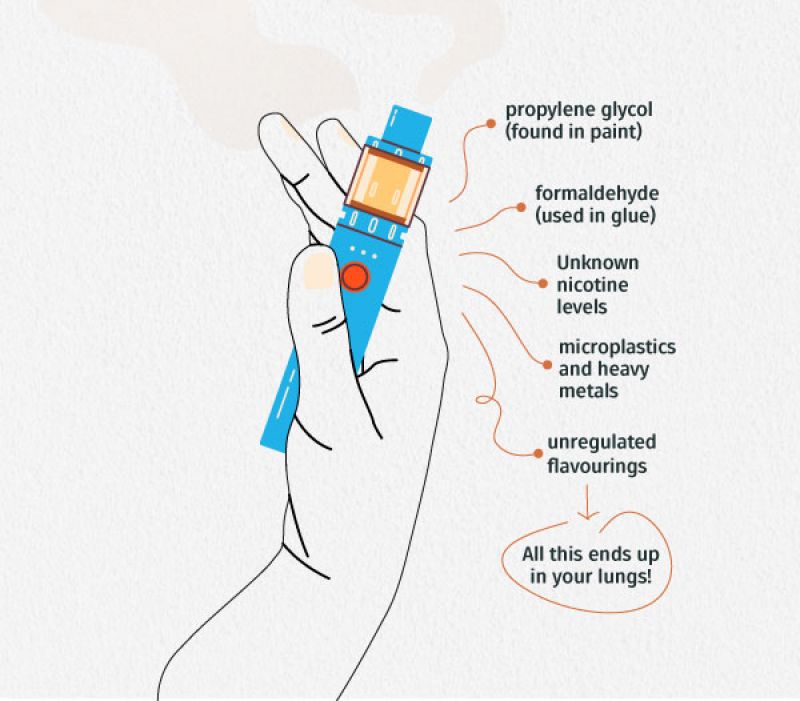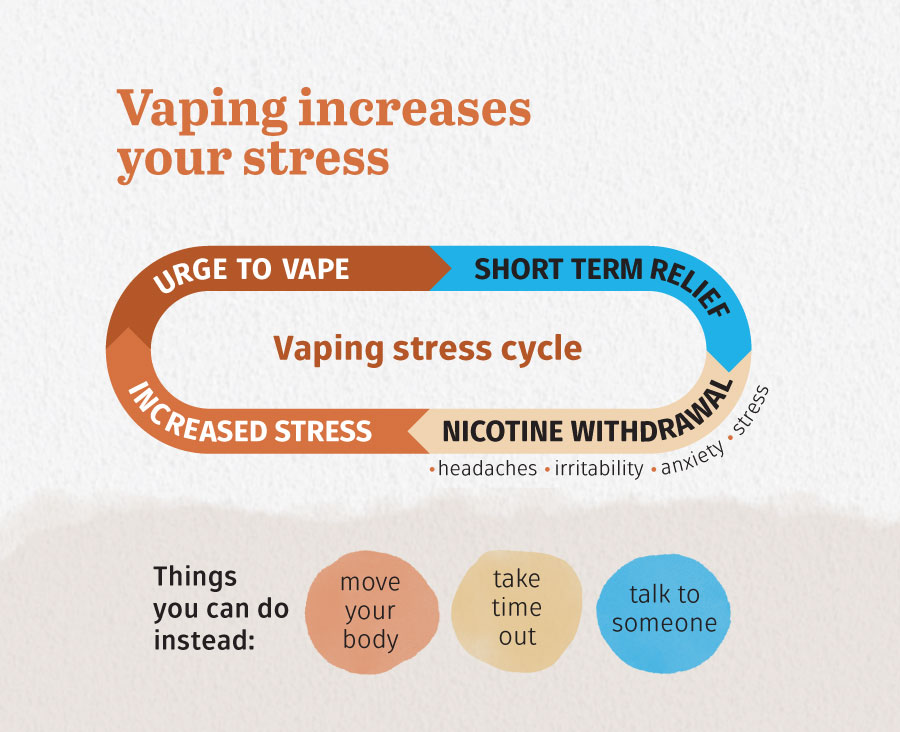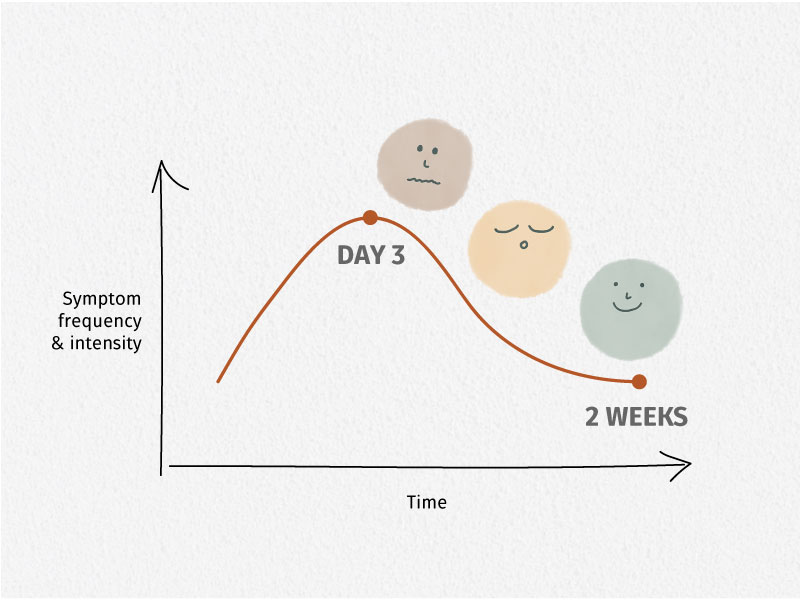
Vaping
On this page:
What is vaping?
Vapes or E-cigarettes are devices that deliver an aerosol by heating a liquid that users breathe in. People commonly refer to this aerosol as ‘vapour’, and to using an e-cigarette as ‘vaping’.
Instead of lighting the e-cigarette with a flame, vaping involves a battery being activated by inhaling or pushing a button that heats liquid-saturated wicks, often via metal coils, and turns the e-juice or tobacco into an aerosol mist, which users inhale.
The device can look like cigarettes, cigars, pipes, pens or memory sticks, and
- may not always list the ingredients of the liquids
- contain a range of chemicals that have not been tested for safety, including those that add flavour
- may contain nicotine even if labelled as ‘nicotine free’.
E-cigarettes may also be known as:
- electronic cigarettes
- e-cigs
- electronic nicotine delivery systems (ENDS)
- electronic non-nicotine delivery systems (ENNDS)
- alternative nicotine delivery systems (ANDS)
- nicotine vaping products (NVP)
- personal vaporisers
- e-hookahs
- vape pens
- vapes
Reference: www.health.gov.au
What's in a vape?
The manufacturing of vapes is currently unregulated so unless you get a prescription vape you can't be sure what is in it. The majority of vapes have incomplete or misleading labelling and often have nicotine in them, even when they say they don’t.
Researchers at Curtin University tested the chemicals and toxicity of 52 flavored e-liquids available for sale over the counter in Australia. The research unveiled a cocktail of chemicals which raise serious concerns about the safety of these products and their risks to the respiratory health of young people.

Things found in vapes in Australia
- Formaldehyde (a toxic chemical known to cause cancer)
- arsenic
- propylene glycol (a solvent used in fog or smoke machines)
- polyester compounds
- anti-freeze (typically used in the coolant of a car)
- vegetable glycerin (a liquid derived from vegetable fat).
Other chemicals found in vapes can include volatile organic compounds (found in paint and heavy-duty cleaning products) and hundreds of carcinogenic additives known to be fatal.
Health Effects:
The health harms associated with vaping include:
- Nausea and vomiting
- Mouth and airway irritations
- Chest pains and heart palpitations
- Nicotine addiction
- Intentional and unintentional poisoning
- Acute nicotine toxicity causing seizures
- Burns and injuries
- Lung injury
- Indoor air pollution
- Environmental waste and fires
- Dual use with cigarette smoking – increasing exposure to harmful toxins
Australian National University 2022

Things you can do to reduce harm
Set limits - keep track of how much you are using.
Avoid using a dry device - this burns the coil, releasing more toxic chemicals
By Law you can’t vape where you can’t smoke.
Quit tobacco smoking – don’t smoke and vape at the same time.
Talk to your GP about a prescription for nicotine – it’s regulated and much safer.
Don’t get “nic sick” – Too much nicotine causes headaches, nausea, and anxiety. Unregulated vapes have unknown nicotine concentrations. Slow down and allow time for the nicotine to take effect.
Vape waste - Poisons, heavy metals and lithium-ion batteries end up in landfill. Reducing use or quitting helps the environment too.
Vaping and the law
It’s illegal to vape anywhere you aren’t allowed to smoke, like public areas. You can receive fines of up to $300.
It is illegal to use, sell or buy nicotine for use in e-cigarettes in Australia without a prescription.
This is where things are right now:
- There is now a ban on the importation of disposable single use vapes. This ban will apply to disposable vapes regardless of whether they contain nicotine. This will significantly reduce the amount of vapes available in the country.
- Also, from January 1, 2024, all GPs can prescribe therapeutic nicotine vapes to help you manage nicotine dependence. Previously, only approved GPs were allowed (about 1 in 20).
- Importation of all non-therapeutic vapes without license and permit forms are banned, regardless of if they say they contain nicotine. This includes vapes ordered under the personal importation scheme for people with a prescription.
- From 1 July 2024 nicotine vapes in Australia are regulated as therapeutic goods. This means they are only available at pharmacies to help people quit smoking or manage nicotine dependence.
- It is illegal for any other business, such as tobacconists, vape shops and convenience stores, to sell any type of vape or vape product.
- Until 30 September 2024, everyone needs a prescription from a doctor or nurse practitioner to purchase therapeutic vapes from a pharmacy.
- From 1 October 2024, people 18 years or over will be able to purchase nicotine vapes directly from a pharmacy without a prescription. People under 18 will still need a prescription to access vapes, where state and territory laws allow it, to ensure they get appropriate medical advice and supervision.
- The concentration of nicotine in vapes sold in pharmacies without a prescription will be limited to 20mg/ml; people who need vapes with a higher concentration of nicotine will still require a prescription.
- Additional changes will limit the flavours available to mint, menthol and tobacco, and require plain pharmaceutical packaging for all vape products.
Note that the reforms are acting to limit the supply and commercial possession of vapes. The reforms won’t criminalise individuals who vape, and the Australian government has no plans to criminalise personal possession or use of vapes.
Am I addicted?
You might be addicted if you:
- vape soon after you wake up in the morning.
- often vape by yourself.
- find it hard to concentrate if you haven’t vaped recently.
- need to vape to stay calm or be in a good mood.
- feel stressed, anxious or irritable if you can’t vape.
- are interrupted by thoughts about vaping (cravings) when you’re doing other activities.
- don’t like leaving the house without your vape.
- struggle to not vape in places where it’s banned (e.g. class, public transport).
- turn to vaping when you’re stressed.
- haven’t been able to quit vaping.
Signs of Nicotine withdrawals
As the nicotine level in your bloodstream drops you might experience unpleasant physical symptoms, increased anxiety, being irritable and strong urges to vape, known as cravings.
These are signs of nicotine withdrawals and can begin within a few hours of not using nicotine.
Nicotine withdrawal isn’t dangerous and doesn’t last for long – the first 2-4 weeks after you quit is usually the hardest as your brain and body get used to working without nicotine.
Having support from friends, family or a health professional can increase your chance of quitting for good.
Nicotine withdrawal symptoms include
- being down or irritable
- being unable to concentrate or think clearly
- feeling anxious, restless or jittery
- not being able to sleep well
- feeling more hungry than usual
- not being able to focus on things apart from vaping

Getting help
How to quit vaping
Dr. Benjamin Veness, JED Expert, offers clear steps to help you quit vaping. Quitting any kind of substance isn't easy, but you don't have to do it alone.
If you think you or a friend might be addicted to vaping, there is help available.
The University of Newcastle acknowledges the traditional custodians of the lands within our footprint areas: Awabakal, Darkinjung, Biripai, Worimi, Wonnarua, and Eora Nations. We also pay respect to the wisdom of our Elders past and present.